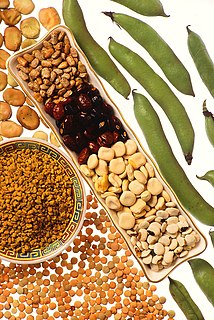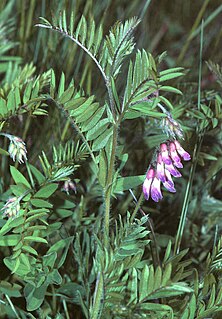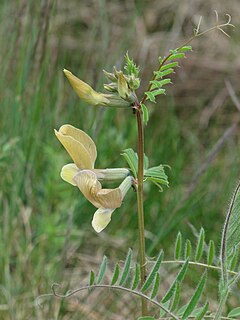
In vitro studies are performed with microorganisms, cells, or biological molecules outside their normal biological context. Colloquially called "test-tube experiments", these studies in biology and its subdisciplines are traditionally done in labware such as test tubes, flasks, Petri dishes, and microtiter plates. Studies conducted using components of an organism that have been isolated from their usual biological surroundings permit a more detailed or more convenient analysis than can be done with whole organisms; however, results obtained from in vitro experiments may not fully or accurately predict the effects on a whole organism. In contrast to in vitro experiments, in vivo studies are those conducted in living organisms, including humans, and whole plants.

Vicia sativa, known as the common vetch, garden vetch, tare or simply vetch, is a nitrogen-fixing leguminous plant in the family Fabaceae. Although considered a weed when found growing in a cultivated grainfield, this hardy plant is often grown as green manure or livestock fodder.

Forage is a plant material eaten by grazing livestock. Historically, the term forage has meant only plants eaten by the animals directly as pasture, crop residue, or immature cereal crops, but it is also used more loosely to include similar plants cut for fodder and carried to the animals, especially as hay or silage.

A legume is a plant in the family Fabaceae, or the fruit or seed of such a plant. When used as a dry grain, the seed is also called a pulse. Legumes are grown agriculturally, primarily for human consumption, for livestock forage and silage, and as soil-enhancing green manure. Well-known legumes include beans, soybeans, peas, chickpeas, peanuts, lentils, lupins, mesquite, carob, tamarind, alfalfa, and clover. Legumes produce a botanically unique type of fruit – a simple dry fruit that develops from a simple carpel and usually dehisces on two sides.

Nevalı Çori was an early Neolithic settlement on the middle Euphrates, in Şanlıurfa Province, Southeastern Anatolia, Turkey. The site is known for having some of the world's oldest known temples and monumental sculpture. Together with the earlier site of Göbekli Tepe, it has revolutionised scientific understanding of the Eurasian Neolithic period. The oldest domesticated Einkorn wheat was found there.

Vicia cracca, is a species of vetch native to Europe and Asia. It occurs on other continents as an introduced species, including North America, where it is a common weed. It often occurs in disturbed habitats, including old fields and roadside ditches.

Vicia is a genus of over 240 species of flowering plants that are part of the legume family (Fabaceae), and which are commonly known as vetches. Member species are native to Europe, North America, South America, Asia and Africa. Some other genera of their subfamily Faboideae also have names containing "vetch", for example the vetchlings (Lathyrus) or the milk-vetches (Astragalus). The broad bean is sometimes separated in a monotypic genus Faba; although not often used today, it is of historical importance in plant taxonomy as the namesake of the order Fabales, the Fabaceae and the Faboideae. The tribe Vicieae in which the vetches are placed is named after the genus' current name. Among the closest living relatives of vetches are the lentils (Lens) and the true peas (Pisum).

Vicia villosa, known as the hairy vetch, fodder vetch or winter vetch, is a plant native to some of Europe and western Asia. It is a legume, grown as a forage crop, fodder crop, cover crop, and green manure. Although non-native, it occurs in all US states and is considered invasive by some states, such as Alaska, Florida, Georgia, Kansas, Michigan, Minnesota, Oregon, and Washington state — as well as in Japan and some parts of Europe where it is not native. It is also found in most Canadian provinces.
1097 Vicia, provisional designation 1928 PC, is an asteroid from the central regions of the asteroid belt, approximately 23 kilometers in diameter. Discovered by Karl Reinmuth at the Heidelberg Observatory in 1928, the asteroid was later named after the flowering plant Vicia, commonly known as vetches.

Vicia tetrasperma the smooth tare, smooth vetch, lentil vetch or sparrow vetch, is a species of flowering plant from the large genus Vicia of the legume family Fabaceaae. It can be invasive.

Orchis anatolica is a species of flowering plant in the Orchidaceae family. It is native to Crete, Cyprus, the East Aegean Islands, Greece, Iran, Iraq, Lebanon, Palestine, Syria, and Turkey.

Leptidea morsei is a butterfly of the family Pieridae. It is found from central Europe to Siberia, Ussuri, Korea, northern China and Japan. The habitat consists of damp, grassy vegetation at the sunny edges of woods, in grassy woodland clearings and on regenerating woodland on grassland. They occur almost exclusively in oak forest and mixed deciduous woods.

Vicia orobus is a species of leguminous plant in the genus Vicia, known as wood bitter-vetch. It is found in Atlantic areas of Europe, especially in the rocky edges of seasonally-grazed fields. It grows up to 60 cm (24 in) tall, and has no tendrils at the ends of its pinnate leaves. Its flowers are white with purple veins, and are borne in groups of 6 or more.

Morchella anatolica is a rare species of ascomycete fungus in the family Morchellaceae. It was described as new to science in 2010 from southwest Anatolia, Turkey, where it grows on moss-covered stream beds in pine forests. An ancient climatic relict, M. anatolica is restricted to the Mediterranean basin and has also been documented in Spain, Cyprus and Greece, where it is sometimes encountered with trees of the Oleaceae family. Together with its sister-species Morchella rufobrunnea, they are the earliest diverging lineages in genus Morchella, forming a distinct clade that is basal in global morel phylogenies. Because of its phylogenetic position, M. anatolica has been crucial in inferring the historical biogeography of the genus, which is estimated to have emerged somewhere in the Mediterranean region in the late Jurassic.

Cellular agriculture focuses on the production of agriculture products from cell cultures using a combination of biotechnology, tissue engineering, molecular biology, and synthetic biology to create and design new methods of producing proteins, fats, and tissues that would otherwise come from traditional agriculture. Most of the industry is focused on animal products such as meat, milk, and eggs, produced in cell culture rather than raising and slaughtering farmed livestock which is associated with substantial global problems of detrimental environmental impacts, animal welfare, food security and human health. Cellular agriculture is field of the biobased economy. The most well known cellular agriculture concept is cultured meat.

Vicia grandiflora, commonly known as large yellow vetch and bigflower vetch, as well as large-flowered vetch, is a common herbaceous plant species in the family Fabaceae, which occurs as a native plant species in Europe and Asia, as well as an introduced vetch species in North America.

Vicia tenuifolia, the fine-leaved vetch and cow vetch, as well as fodder vetch and bramble vetch, is a herbaceous perennial plant species in the family Fabaceae. This species grows widespread in Europe and some parts of both Asia and Africa. In some other areas it occurs as an introduced species. In few countries this edible vetch is used in both human and farm animals nutrition.
Rachel Leech was Professor of Plant Sciences at the University of York, UK. Her research focused on chloroplasts and she was a leader in the field of understanding their development and function. She was also one of the early adopters of Arabidopsis thaliana as a model plant to identify the genes involved in chloroplast division.

Vicia bithynica known as Bithynian vetch, is a species of flowering plant in the bean family Fabaceae. It was described by Carl Linnaeus, initially as Lathyrus bithynicus but later moved to the genus Vicia (vetches). The specific name is derived from Bithynia, an ancient kingdom situated on the north coast of Anatolia, in modern day Turkey.















